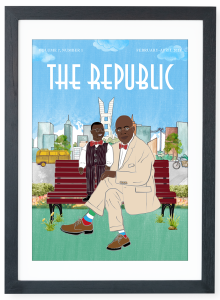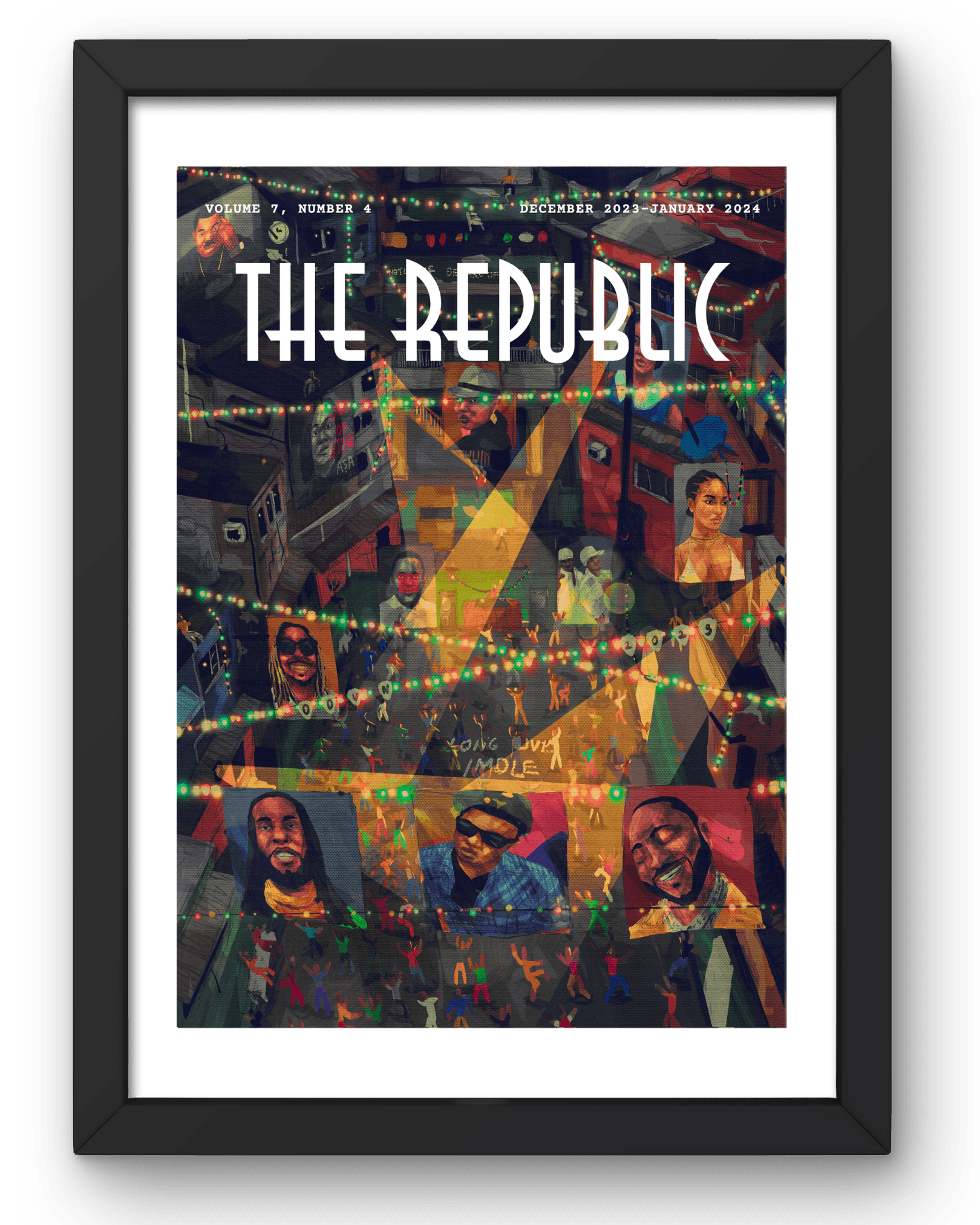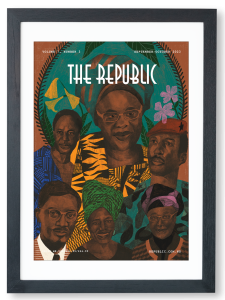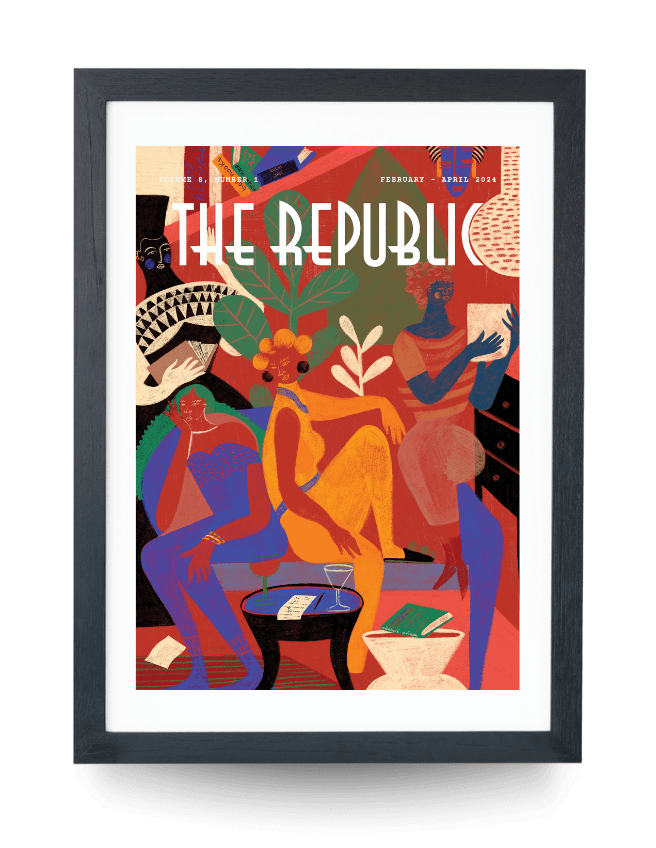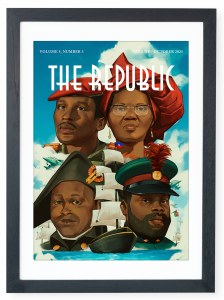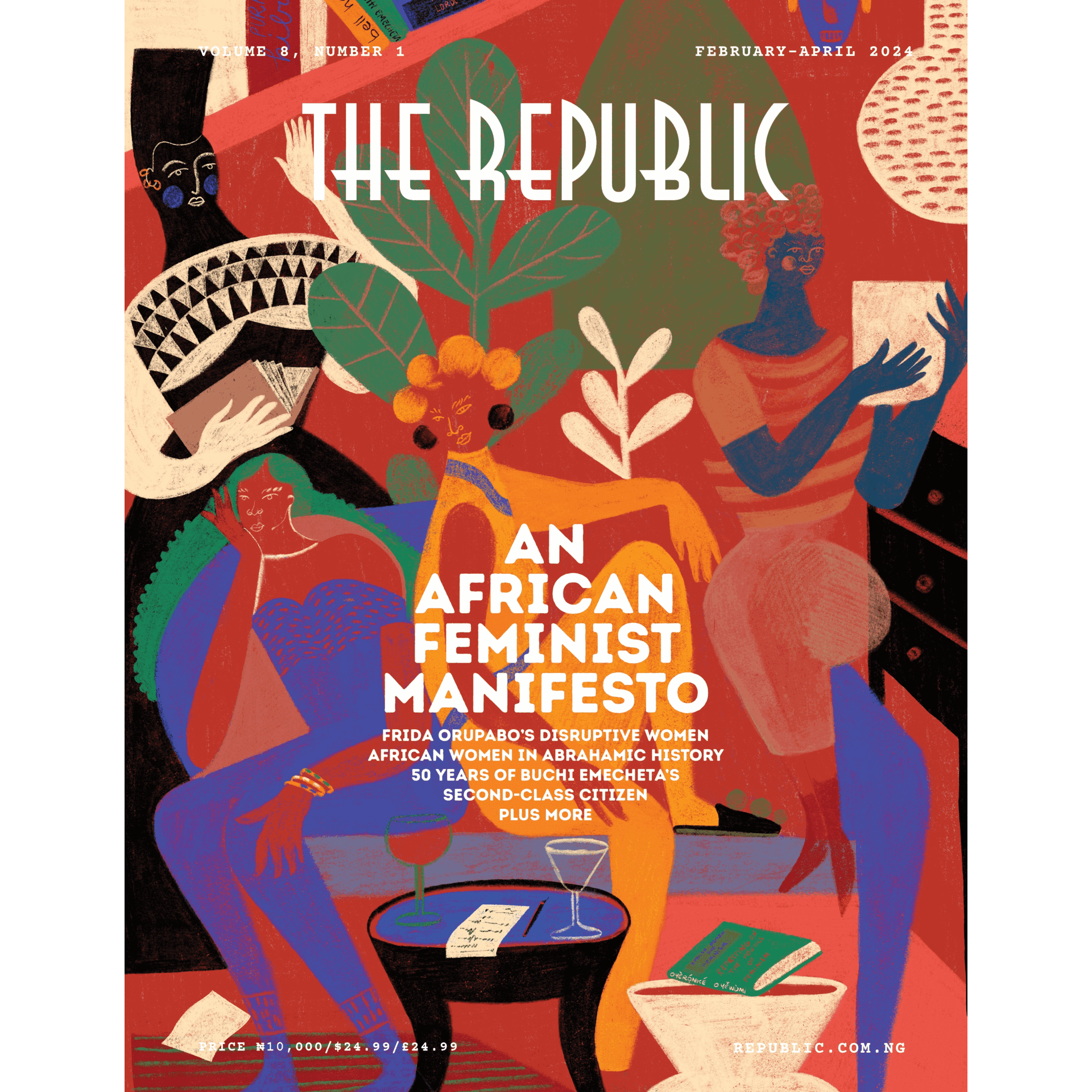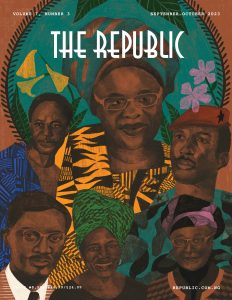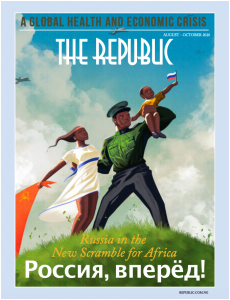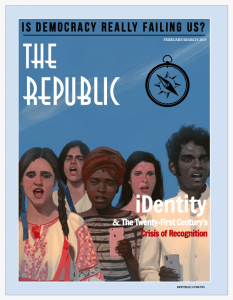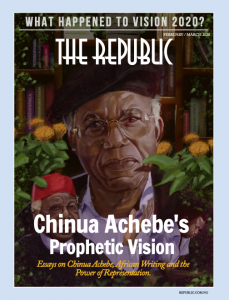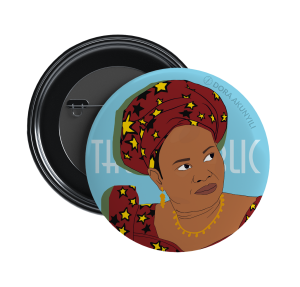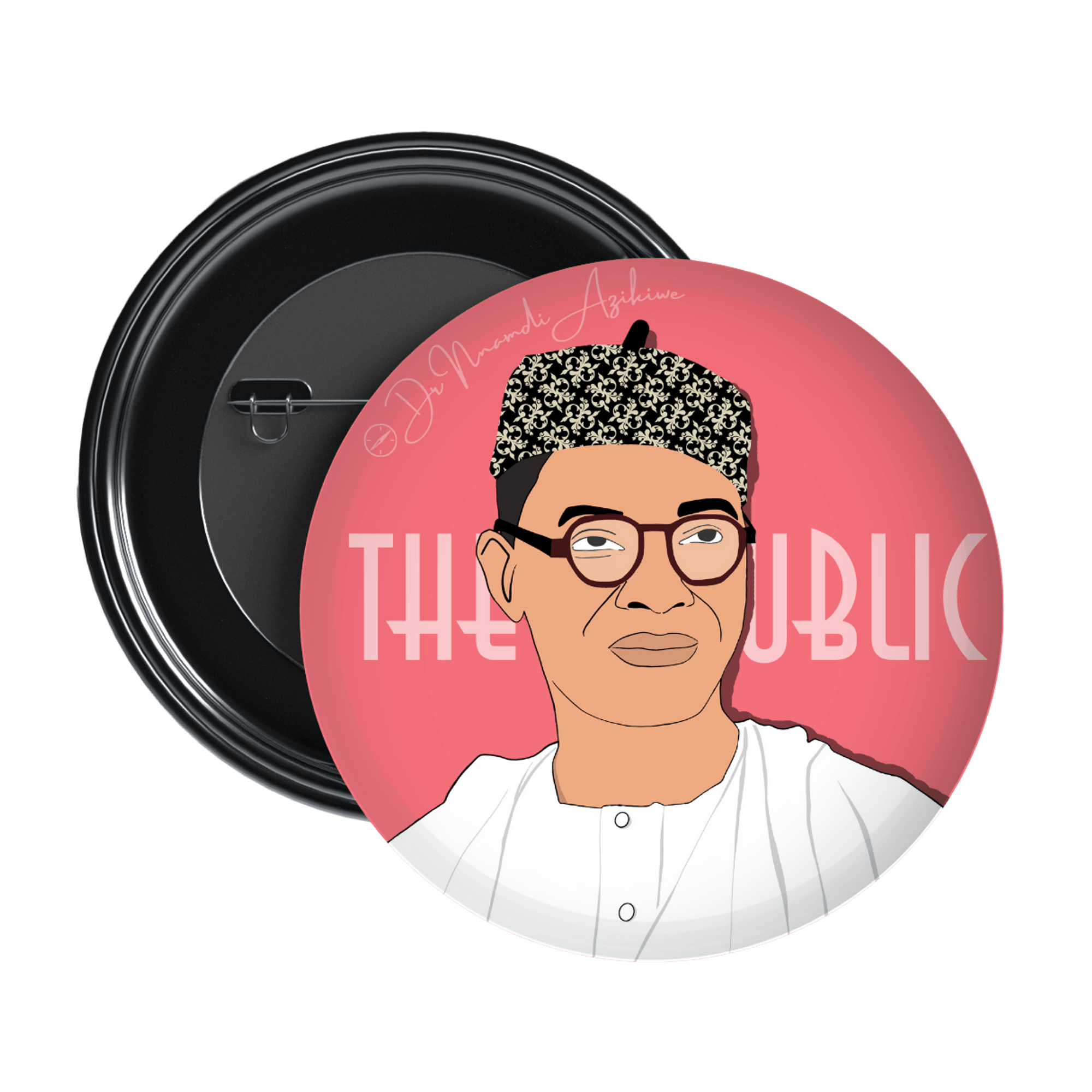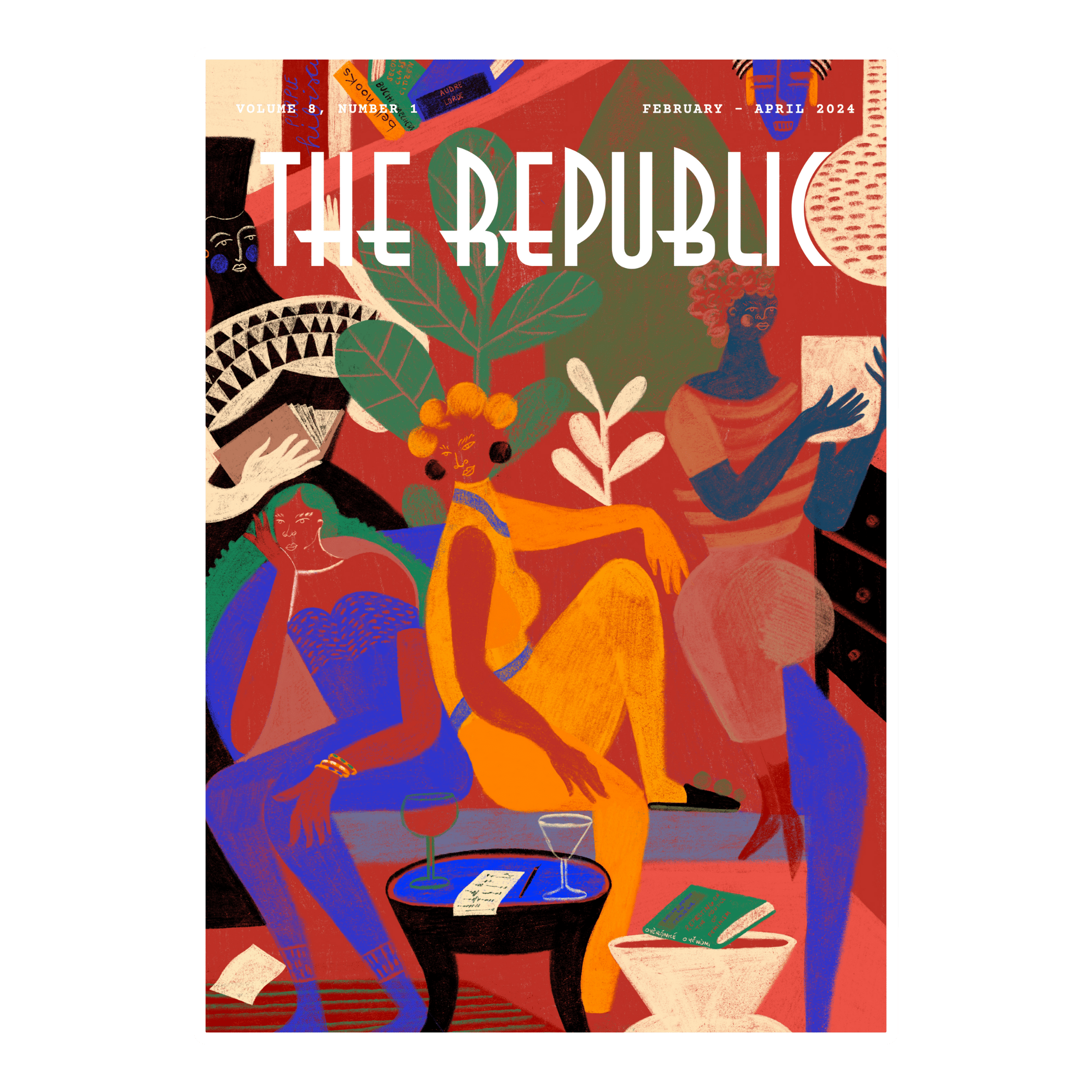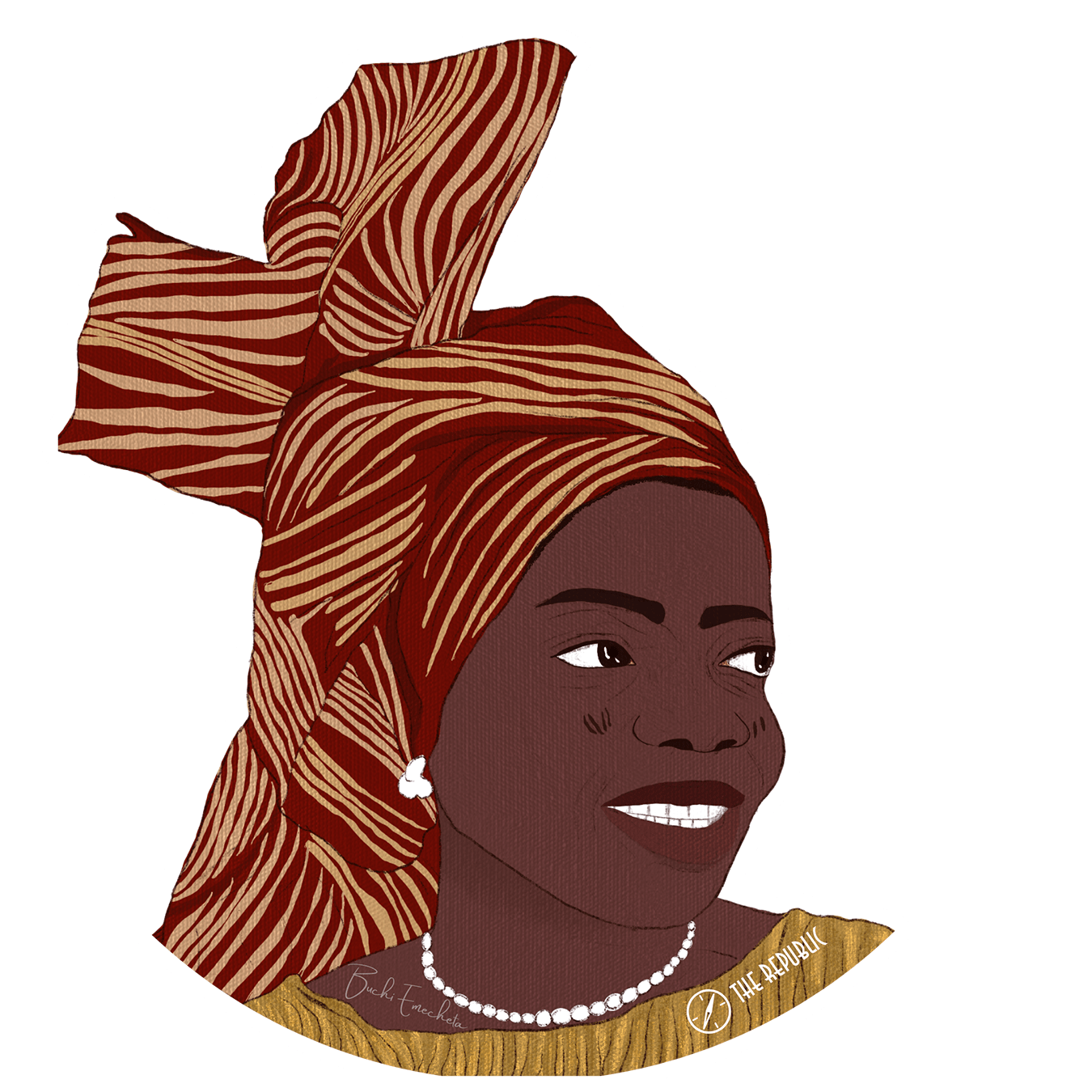THE MINISTRY OF MEMORIES
A Womanist Reading of African Women in Abrahamic Tradition
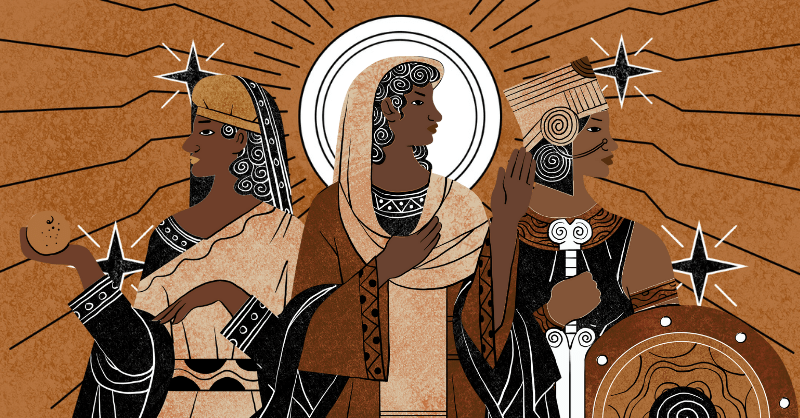
Illustration by Charles Owen (blvninjv).
THE MINISTRY OF MEMORIES
A Womanist Reading of African Women in Abrahamic Tradition
Support for this essay came from the Open Society Foundations Ideas Workshop.
With the Bible being one of the only texts available for Africans enslaved in the Atlantic world to become literate in secret or otherwise, and with the underestimated presence of enslaved African Muslims who were indeed literate in Arabic, conceptions of Africa were deeply influenced by generational memory, and by Biblical and Qur’anic scripture. It is thus no surprise that some of the earliest and most notable abolitionist, pan-Africanist, and anti-colonial leaders in the Black Atlantic often framed their liberatory ideologies with Abrahamic conceptions of God. These associations prevailed throughout the 20th century; the stories of Moses (AS)* and Bilāl ibn Rabāḥ (RA) reverberated as symbols of spiritual and political redemption in mass, male-led movements from the Universal Negro Improvement Association to the Nation of Islam.
Yet, there was no absence of women who embraced Blackness within Abrahamic tradition in their political and artistic work, recovering glimpses of their own history and ancient representations of themselves. Moreover, though Abrahamic narratives of heroic male prophets and leaders became critical to male-dominated Black liberation movements, African women within Abrahamic narratives also became symbols of profound sacrifice and spiritual deliverance, catalysing powerful resistance and new cosmologies among masses of Black people fighting against erasure.
Embodying this spirit of sacrifice and spiritual deliverance, African women in Abrahamic tradition are often presented and re-presented through themes of divine maternity. In Judaism, Christianity, and Islam, African women (and women more broadly) are often responsible for literally birthing and nurturing new revelations, new nations, and subsequently new eras within Abrahamic tradition. Three African women in Abrahamic tradition in particular have historically been drawn on by Black leaders for physically embodying what Islamic scholar and activist, Shaykha Iesha Prime, described as the ‘meeting between the heavens and the earth,’ and ‘divine decree’: Hajar (Hagar), the Black Madonna (Mary), and the Queen of Sheba (Makeda/Balqis) (RA).
Though not the only African women in the Abrahamic tradition who represent this motif, their significance is marked by their direct bodily intercession and self-sacrifice to build new nations. Their roles inspired and are replicated through art and literature by Black women who identify with their struggles and triumphs, and through new interpretations of Abrahamic religion which recentre their roles as Black women. Their narratives are also replicated through other African cosmologies in both the ‘New’ and ‘Old’ worlds, which have historically integrated these Abrahamic traditions in the deification of motherhood and in the (re)building of narratives of the birth of a people.
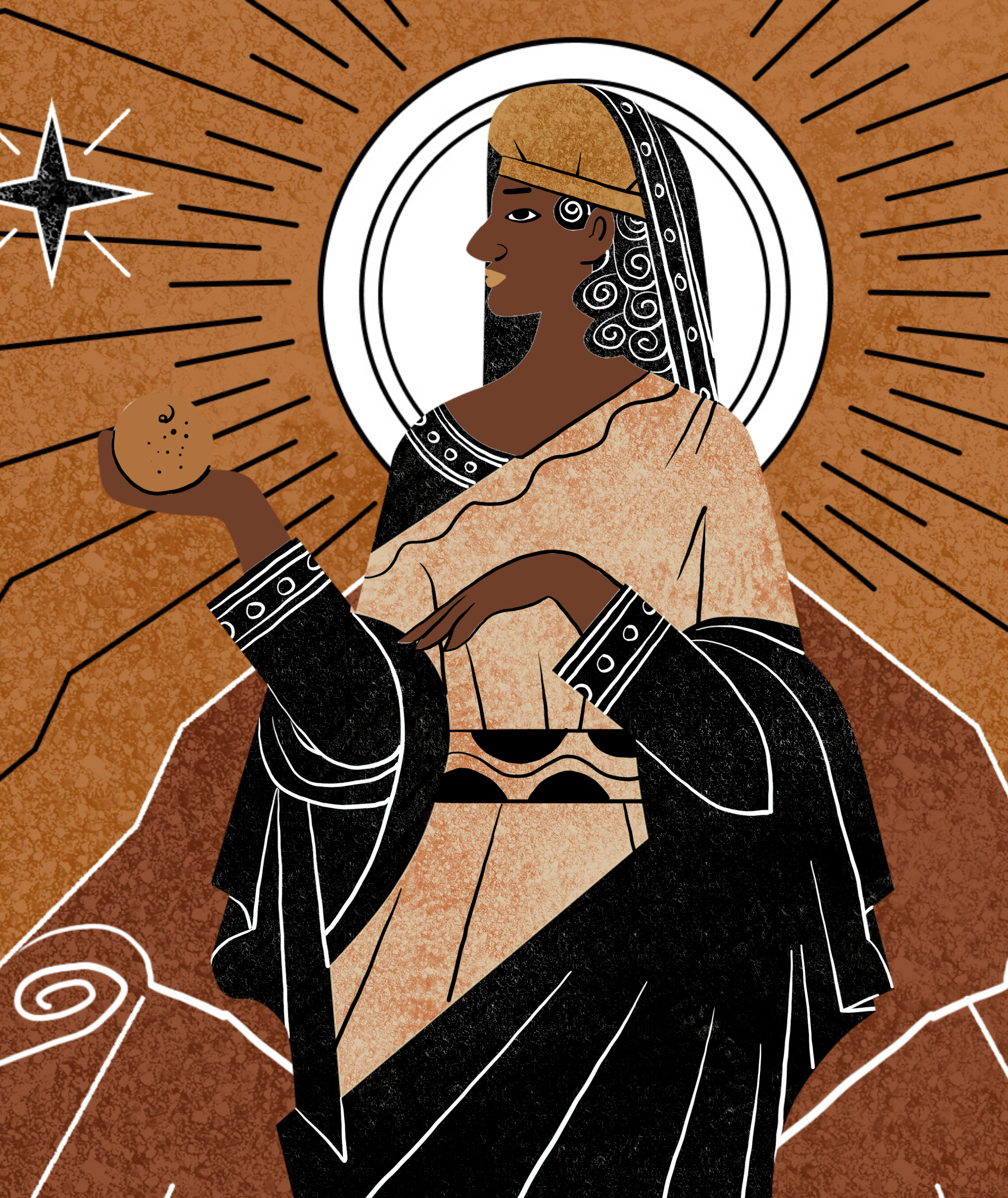
‘OUR MOTHER HAJAR’
Arguably the most critical narrative which links Judaism, Christianity, and Islam is the story of Ibrahim (Abraham) (AS), Sarai (Sarah), and Hajar (Hagar) (RA). It would be Hajar and Sarai who give birth to the two most significant lineages in Abrahamic tradition, Isma’il and Ishaq (Ishmael and Isaac), respectively (RA). According to Abrahamic tradition, the former was an Egyptian woman, a daughter of the pharaoh gifted to Sarai as a servant while in Egypt. In order to fulfil the prophecy which foretold that Ibrahim would father nations, Sarai, unable to conceive, permitted Ibrahim to conceive a child either in or out of wedlock with Hajar—a point of departure between Islamic and Judaic/Christian accounts, respectively. From this union, comes Isma’il, and begins the story of divine matrilineality, which leads to the Islamic Prophet Muhammad (AS), and of Abraham and Sarah, the Christian Messiah, Jesus (AS) . With or without malevolence and abuse from Sarai, depending on the tradition, Hajar is cast into the desert with Isma’il, where God offers provisions and the promise that Isma’il, too, will be a father of nations. Despite this, in the Judaic and Christian tradition, Ishaq is the rightful firstborn protagonist of the Old Testament and Hagar and Ishmael fade away from the narrative.
Though Hagar endures on the periphery of Biblical and Judaic tradition, she remains critical throughout Black womanist readings of Abrahamic tradition, most famously among Christian theological scholars like Renita Weems and Delores Williams. Biblical scholar, Nyasha Junior, writes that Weems’ seminal work, Just a Sister Away: A Womanist Vision of Women’s Relationships in the Bible (1988), ‘was the first book within biblical studies identified as a womanist work.’ Williams’ work, Sisters in the Wilderness: The Challenge of Womanist God-Talk (1993), Junior added, ‘has become a standard text in theology,’ as it ‘brought renewed attention to biblical Hagar and to African American appropriation of Hagar.’ These pillars of a Black womanist reading of Abrahamic tradition themselves draw on historiography of other African women who have integrated her into works of narrative and artwork. Toni Morrison’s Song of Solomon (1977), features Hagar, the rejected lover of the main character Milkman; in 1902 writer Pauline Hopkins published a serial novel, Hagar’s Daughter, which follows an alleged slave-woman, Hagar, who also becomes rejected and estranged from her lover, eventually jumping seemingly to her death to save herself and her daughter. In 1895, Afro-indigenous artist, Edmonia Lewis, presented her sculpture, Hagar, in the neoclassical style, pictured without the young Isma’il, with her hands clasped in prayer, facing up towards her Lord, at her feet what assistant professor in Black religious traditions, Oluwatomisin Olayinka Oredein, calls ‘Abraham’s filicidal parting gift, a water skin.’ What these interpretations have in common, Junior cites Dolores Williams, is the congruence ‘with many African American women’s predicament of poverty, sexual and economic exploitation, surrogacy, domestic violence, homelessness, rape, motherhood, single-parenting, ethnicity and meetings with God.’ The story of Hagar offers a spiritual catharsis of sorts, an ‘analogue for African American women’s historic experience.’
In her 2022 article, ‘Hagar’s Textual Agency: Diversifying Christian Womanist Sources of Interpretation,’ Oredein writes that ‘though not textually positioned as such, for marginalized communities, Hagar is a pivotal character within the Hebrew Bible.’ It is indeed ‘her minor status being precisely what most qualifies her importance,’ continues Oredein. ‘Hagar is a compass; a meaning-making agent within a text that has diminished or completely ignored the lives of sun-kissed communities of African descent.’ It is the very convergence of ‘hardship’, ‘survival’, and ‘contact with the divine’, that ‘inspires deep faith’ within the struggle of Black womanhood.
However, the rise of Islam through Prophet Muhammad (AS) reintroduces Hajar as a central figure in Abrahamic tradition and reframes Hajar’s rejected status to centring her legacy as the mother of the Ummah, or the people united by faith, who will in turn come to redemption through her lineage. In the Islamic tradition as told by Shaykha Iesha Prime, Ibrahim is commanded to take and leave her with her son in the desert, to which she responded, ‘then Allah (SWT) is sufficient for me and He will take care of me’. The moment defines her critical display of tawakkul or complete reliance on God, which adorns her the title ‘Our Mother Hajar’.
Through her perseverance in the harsh Arabian desert, she meets the messenger angel Jibril who ‘splits open the Earth and the well of Zamzam comes forth,’ which becomes the site of Makkah, or Mecca. A spiritual and genealogical mother to Islam, in a lecture entitled, ‘We Root Ourself in Beautiful Intentions Made in Our Heart,’ Shaykha Prime asserts that, ‘Literally, Allah (SWT) builds the holiest city around her,’ where the last revelation, in the Islamic tradition, is made by the Prophet Muhammad (AS) who was born there. She describes that if Hajar ever expressed any doubt of God’s plan, the present moment would prove that because of ‘the seed of iman (faith), of tawakkul, of taqwa (God-consciousness)’ that was in her heart, ‘people are going to walk in [her] footsteps just to complete their faith.’ Shaykha Prime meant this quite literally, as one out of the five obligatory duties of every Muslim, otherwise known as the Five Pillars, is Hajj. The annual pilgrimage brings together Muslims from across the world to walk the path of Hajar and visit her grave.
Oredein points to three things within the Islamic tradition that can characterize the story of Hajar: water, abandonment, and wandering. Between abandonment and wandering, she describes, marks the ‘ground as fertile for new life,’ and ‘comes the possibility for new communal life.’ On the role of water and divine intervention in the narrative, Oredein writes, ‘the earth’s body holds something that Hajar’s body needs, and in this, revelation bombards bodily contact.’ Similarly, Shaykha Prime refers to the woman’s role in Islam and Abrahamic tradition more broadly as the vessel for ‘divine decree,’ as the hadith of the Prophet (AS) in Sahih Muslim states that the ‘womb is connected to the throne of Allah (SWT).’ However, this is not to say that women are simply machinery for revelation, but instead a guardian of the ‘Unseen’ before it is manifested on earth. Thus, women are the physiological and spiritual foundation of each pivotal moment for the beginning of a new nation and corresponding doctrine.
THE MULTIPLE EXPRESSIONS OF BLACK MADONNA
It is the birth of Jesus (AS) through the Virgin Mary (Maryam) (RA) that brings us into the New Testament, into a new nation and a new doctrine. In much the same way, the iconographic traditions of the Madonna, or the Virgin Mary pictured with the divine baby Jesus, is a tradition which brings us to the early Common Era, or the Medieval Period. Within this artistic innovation is the perplexing tradition of the Black Madonna. Artist and scholar, Yelaine Rodriguez, writes in her 2022 chapter article, ‘Reading Against the Grain of the Black Madonna: Black Motherhood, Race, and Religion,’ that, ‘three hundred Black Madonnas exist in both painted and sculptural form,’ including one dated as early as the 8th century in Sicily, ‘with a Latin inscription that states, “I am Black.”’ Rodriguez relays of the Black Madonnas that they are often understood as acheiropoieta, or Christian iconography which appear miraculously and without human intervention. She explains there is much debate on whether these medieval Black Madonnas were indeed intentionally adorned with darker skin by their fabricator—divine or otherwise—or if it was a matter of simple environmental exposure over time. She writes that there are two camps which deny ‘Blackness of part of her “initial” origin, the first are those who believe “her Blackness must be a miracle, inexplicable by natural or scientific laws, but a divine occurrence rather than her natural complexion,”’ and those who attribute her Blackness to the ‘accumulation of smoke from the candles [used in rituals], and other environmental factors.’ This, Rodriguez asserts, is an expression of anti-Blackness, as ‘coming to terms with the possibility that Mary herself could have been of colour is not an option.’
Nevertheless, this has not stopped the integration of the iconic motif into Black consciousness. In her analysis, Rodriguez uses the example of the Black Madonna found ‘in Jerusalem in 326 by Saint Helena,’ later appearing in Czestochowa, Poland in the 14th century. This image would become a critical visual representation during the Haitian revolution in the early 19th century. Rodriguez writes that in the early 1800s, ‘the Black Madonna made her way into Haiti in the form of cheap miniature lithographs within the pockets of Polish soldiers sent forth by Napoleon,’ ultimately defecting to the side of the Haitians. This solidified, writes Rodriguez, the ‘Haitians’ beliefs that the lithograph of the Black Madonna that Polish troops brought with them was, in actuality, Erzulie Dantor.’ Ezrulie Dantor, ‘regarded as the mother of Haiti,’ has origins at the ‘inception of the uprising, as Haitian accounts speak of a Vodou ceremony (Bois Caïman ceremony) before the uprising of 1791 against the French colonizers,’ in which the new loa (deity) emerged. There was a convergence of iconography, aesthetic, and meaning in divine motherhood.
The Black Madonna was also imported into Afro-Cuban tradition, discusses Assistant Professor of Religion, Elizabeth Perez. In a 2010 journal article entitled ‘The Virgin In The Mirror: Reading Images Of A Black Madonna Through The Lens Of Afro-Cuban Women’s Experiences,’ she writes that of the four Marian images from Spain, which ‘became associated with West African, specifically Yorùbá, spirits in Cuba,’ it was ‘Yemayá’ which is the ‘only Marian image in Cuba considered to be Black,’ and ‘explicitly described as such by devotees.’ She is a critical figure for ‘practitioners of the Afro-Cuban religious formation called regla ocha or Lucumí, and more popularly Santería.’ Though she is consistently portrayed ‘as the most abused of spirits’, she is also characterized by her great ‘power over the seas, defence of infants, and constant displays of solicitude for her followers.’ These powers are represented through her maternity, discusses Perez. She writes that ‘the lacteal waters swelling at the dawn of time,’ gave rise to phenomena personified by other oricha, ‘such as nature, weather, disease, craft, agricultural labour, fertility, warfare, and death,’ linking Yemayá and Mary as ‘The World’s Wet Nurse,’ that is, the one who nursed and ushered a new way of life unto the Earth.
Yes, the Black Madonna, Erzulie, and Yemayá converge as an expression of a distinguished motherhood which embodies the inception, the genesis of multiple Black historical traditions. It is this tradition of divine motherhood which subtly underpins the most critical junctures of Abrahamic tradition, and it is these points in particular which Africans have historically integrated into their consciousness. Yet, there are schools of thought which actually challenge the theory of Africans as receptacles of Westernized traditions, by asserting that it is Africans who have transferred their traditions to these early critical traditions, which have been Westernized and Eurocentricized overtime.
Rodriguez is arguably one scholar who assumes this position when she writes that ‘the most logical explanation,’ for the appearance of the Black Madonnas which come to influence so many African cosmologies, is that some of the oldest iconographies ‘“are imported figures of Isis,” as stated in a newspaper clipping from 1899 in The New York Times.’ The archaeological link between the Egyptian Goddess, another divine maternal figure, and the Madonna, Black or otherwise, is not necessarily clear. In ‘Divine Mothers: The Influence of Isis on the Virgin Mary in Egyptian Lactans-Iconography,’ Sabrina Higgins writes on the study of the iconography of Isis lactans and Madonna lactans, or image of breastfeeding a divine child, Horus and Jesus, respectively. She writes that ‘the lack of evidence for Isis lactans after the fourth century CE and the absence of any representations of Maria lactans which are definitively dated prior to the seventh century end any discussion of a direct chronological sequence between Isis and Maria lactans in Egypt.’ However, she differentiates between ‘cultic’ adoption of a god/goddess, and the adoption of imagery. On this latter point, she contends that the Roman monks in whose rooms the images of Madonna lactans were found, were indeed ‘borrowing this image from the familiar iconographic repertoire of Isis,’ and that ‘the same notion of iconographic borrowing can also be seen with the ankh-cross.’ In other words, while the visual aesthetic and imagery of Isis was borrowed, it would ultimately ‘have been understood within a distinctively Christological framework.’ However, arguably, even if there was no cultic adoption of Isis, the adoption of the iconography could not be purely coincidental; perhaps these Roman Christian monks understood the maternal link between Isis and Mary, otherwise, there are a myriad of other feminine aesthetics they might have adopted iconography from.
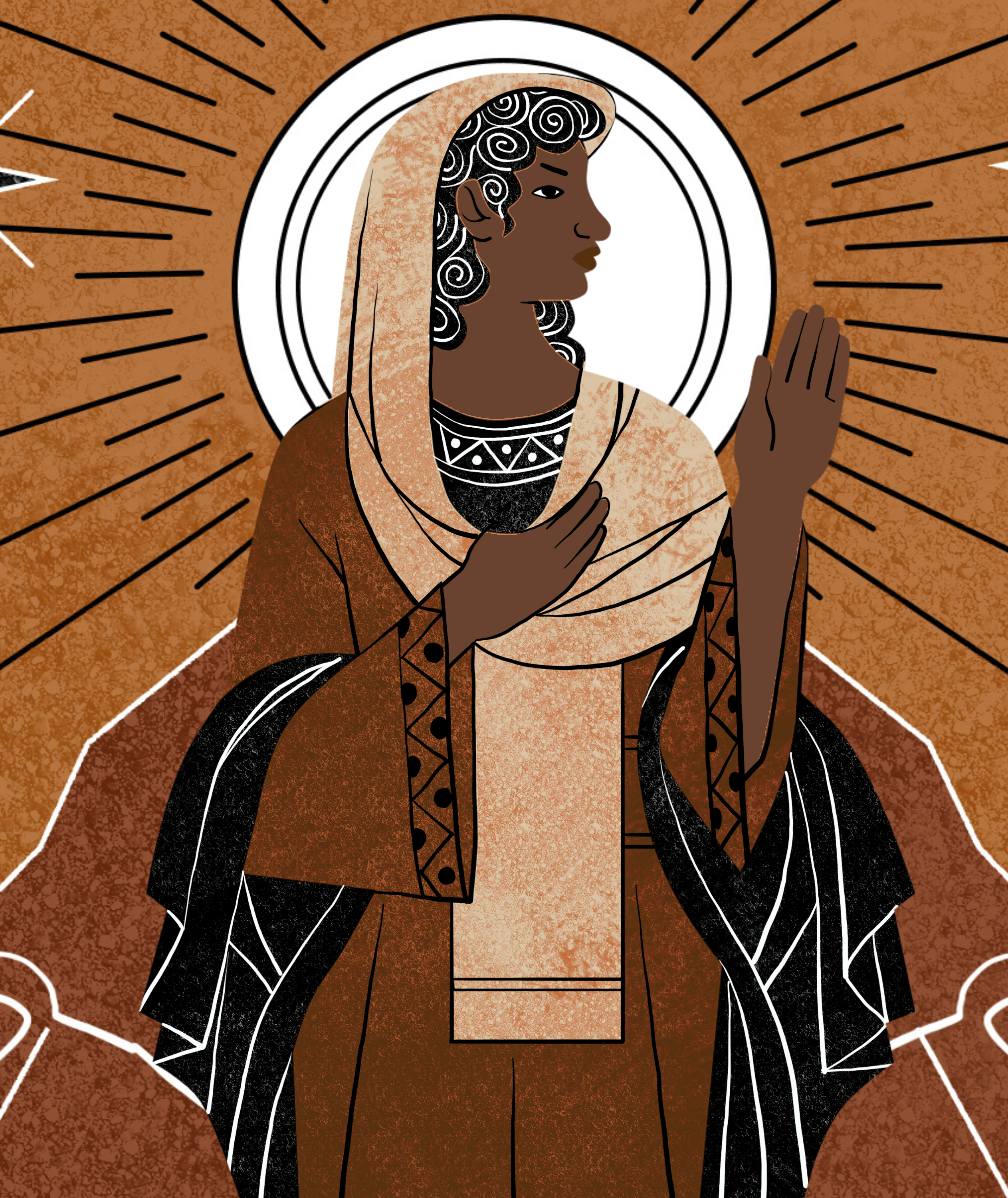
shop the republic
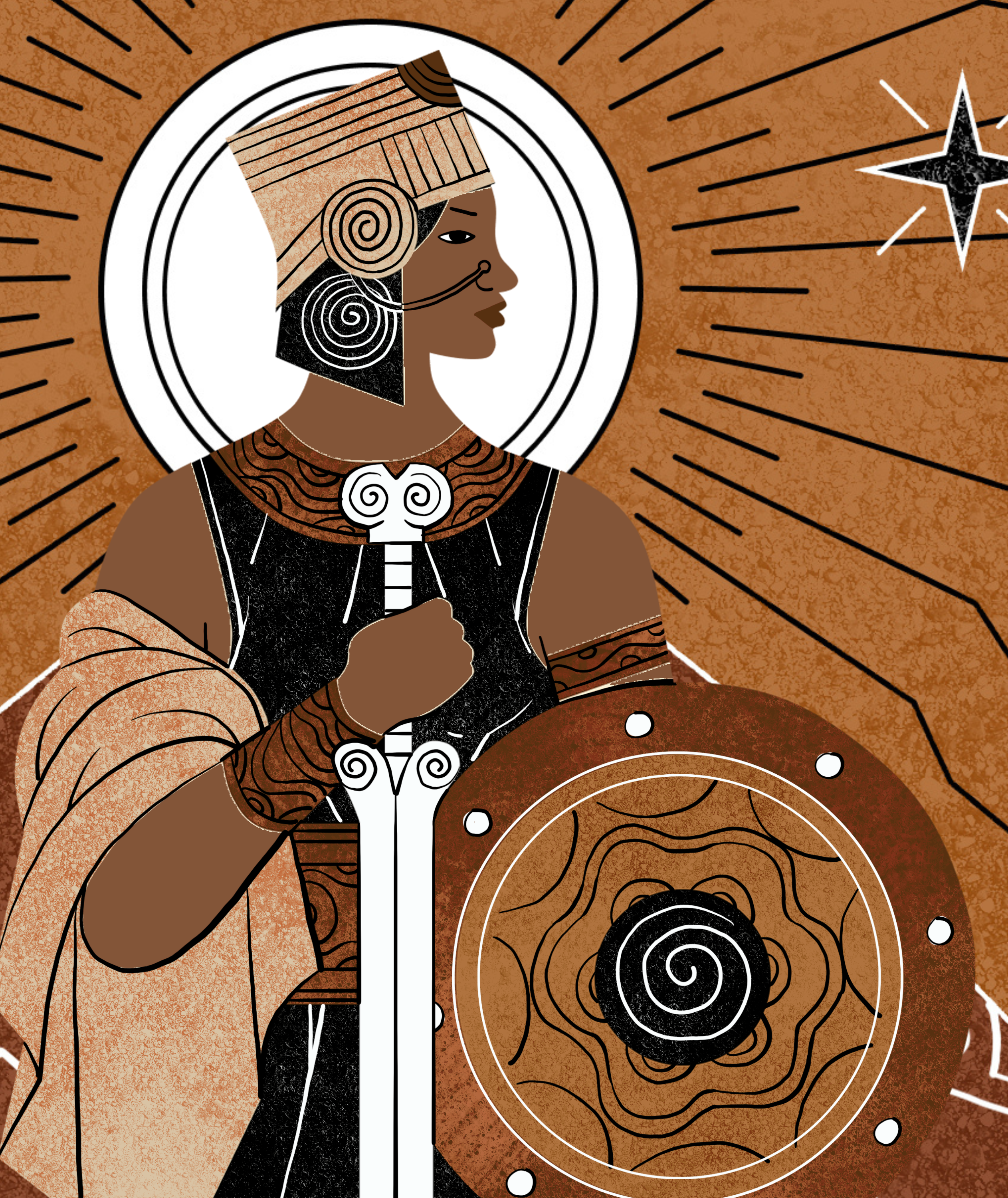
THE DIVINE MOTHERHOOD OF THE QUEEN OF SHEBA
Nevertheless, it is the maternal divinity of the Black Madonna that would also be linked with the Queen of Sheba in the medieval period through the fourteenth-century Ethiopian religious and proto-nationalist text, The Kebra Nagast, marking a new beginning in how sovereign legitimacy was established in the Ethiopian empire. Also known as Queen Balqis in the Islamic tradition, and Makeda in the Ethiopian tradition, ‘the oldest account of the Queen of Sheba,’ writes anthropologist Carolyn Fluehr-Lobban in her 2021 article, ‘Queen Balqis, “Queen of Sheba,”’ comes from the ‘Old Testament book of Kings,’ which describes the events ‘during the period of the 39-year reign of King Solomon, 970–931 BCE.’ The story links Judaism, Christianity and Islam as the encounter of the Queen of Sheba, who travels with a great caravan to visit King Solomon (AS) in Jerusalem, a prophet in Islamic tradition. By dupe, love, and/or politics, Makeda and Solomon become intertwined, sexually in some traditions, and a symbol of the expansion of Abrahamic tradition into other lands.
However, politics in geography has confined her to racial ambiguity. Scholar of the Diaspora in Latin America and the Iberian Peninsula, Miguel Alejandro Valerio, writes in his 2016 article ‘The Queen Sheba’s Manifold Body: Creole Black Women Performing Sexuality, Cultural Identity, and Power in Seventeenth-Century Mexico City,’ that recent scholarship asserts that the Queen of Sheba hailed from the circum of the Red Sea region,’ however, there still debate on whether she ‘was from the southern corner of the Arabian Peninsula [present-day Yemen]; and another that she hailed from northeastern Africa [present-day Ethiopia].’ Perhaps these designations are too simplistic, as there is historical evidence of the Ethiopian empire once exercising dominion over both areas, and even a chapter in the Qur’an, entitled The Elephant (Al-Fil), which speaks of one particular expedition to destroy the Ka’bah by one Abraha, an Abyssinian governor in Saba’ or Sheba. In any case, while Biblical and Qur’anic traditions do not give much in the way of ethnic or racial identity of the famous Queen, it would be the Ethiopian Kebra Nagast (Glory of Kings), which asserted her identity as a Black African woman and the mother of a new Ethiopian imperial state legitimized by her role in Abrahamic tradition. Historian, Monique Bedasse, in her 2010 article ‘Rasta Evolution: The Theology of the Twelve Tribes of Israel,’ writes that the ‘Kebra Nagast tells the story of Makeda traveling from Ethiopia to Jerusalem to see Solomon, of whose wisdom she had heard. Solomon and Sheba produced an offspring, Menelik I, who was born in Ethiopia. As the story goes, Menelik I became the first King (out of the line of Judah) of Ethiopia.’ The Kebra Nagast also relays that when Menelik I grows up and visits Jerusalem, he rejects his father’s invitation to stay, and returns to Ethiopia. Unknowingly carrying within his caravan the Ark of the Covenant, prompting King Solomon to have a dream in which the sun ceases to shine over Jerusalem and transfers unto Ethiopia—the new Zion.
The Kebra Nagast is both a confirmation of the Queen of Sheba’s racial identity and of the rebirth of Ethiopian sovereignty. Though the Ethiopians would be the first in the early modern era to more notably assert Makeda’s racial identity, Valerio writes that one of the earliest textual claims of the Queen’s African origin actually started with the Judeo-Roman historian, Josephus, in the first century CE, who wrote in his Antiquities of the Jews that ‘there was then a woman queen of Egypt and Ethiopia.’ It was this which informed the medieval interpretation of the passage of the Biblical book of Song of Solomon—the namesake of Toni Morrison’s aforementioned book–—which reads: ‘I am Black and lovely; daughters of Jerusalem; dark like the tents of Kedar; like the tent curtains of Solomon.’ This passage would come to simultaneously characterize the Queen of Sheba and the Black Madonna in the medieval period. Similarly, within the Kebra Nagast, the divine motherhood of the Queen of Sheba is also connected with that of Mary (RA). Historian Steffan A. Spencer writes that throughout the Kebra Nagast,
It is described that just as the Ark served as the vehicle by which the precious Ten Commandments of the Law were given unto humanity as a sign of the Old Covenant, so too would Mary serve as the perfected and purified vehicle by which the New Covenant would be revealed through Christ.
That the Ark of the Covenant was brought into Ethiopia, bringing God’s favour with it, through the maternity of the Queen of Sheba is directly parallel to the New Covenant and favour brought through Mary by Jesus (AS). This became important not just to the Ethiopians, but to the diaspora in particular, who turned to Ethiopianism in order to interpret their plight and fate in the Atlantic world. The narrative Queen of Sheba became their indigenous right to Christianity, and in part, a path to historical claims to Islam and Judaism, giving rise to a range of pan-Africanist groups from the Rastafarians to the Black Israelites who were at the forefront of Black liberation.
shop the republic
NOT TALES OF THE ANCIENT
African women in Abrahamic tradition were not just passive vehicles for revelation; from Hajar to reimagined figures like Erzulie Dantor and Yemaya, it was their conscious and deliberate choice to physically engage in modalities of resistance, resilience and steadfastness which birthed new nations, new ways of life. But as Shaykha Prime asserts, these are not tales of the ancient, or even our recent historical past, but lessons for our present moment—whether or not one subscribes to Abrahamic religion. For example, South African Foreign Minister, Naledi Pandor, a Muslim woman, has openly been at the centre of international support for Palestine. Indeed, she has been the outspoken spearhead of the legal charge of genocide brought by the government of South Africa against Israel at the International Court of Justice. The case was brought to the ICJ by Pandor on 29 December 2023, and was largely ruled in South Africa’s favour on 26 January 2024.
At Masjidul-Quds, a mosque in Cape Town with the Arabic namesake of Jerusalem, ‘al-Quds’, Pandor addressed a crowd about the ruling by stating that she first wanted to ‘frame our solidarity with the people of Palestine and, indeed, our overall foreign policy with references to the approaches of the Abrahamic religion to justice, equality, and fairness.’ She then went on to quote a hadith, a saying of the Prophet Muhammad (AS), which ‘enjoin us to support the oppressed in their struggles and engage in activities that will hold the oppressors accountable for their actions. It is thus an injunction against siding with the oppressor, and also to ensure that oppressor cannot act with impunity.’ She then stressed that ‘the same values that I have referred to, of the promotion of fairness, justice, and solidarity with the oppressed are to be found in Judaism and Christianity.’
She cited South African Jews for a Free Palestine (SAJFP) in saying that ‘Zionism and its concomitant oppression of the Palestinians is in conflict with some of the more important values of Judaism,’ which draws on ‘liberatory values,’ including ‘concept of tzedakah,’ which is a religious obligation to contribute time and resources to impoverished communities; a practice parallel to Islamic sadaqah. The SAJFP asserted that, ‘to be Jewish is therefore intrinsically connected to keeping our eyes open to injustice, that is our spiritual and historical duty, reiterated through the experiences of our ancestors and our teachings.’ Though one may assume that the conflict, on the religious plane, is between Muslims and Jews, the presence of Christians in the area is equally and historically relevant. Thus, Pandor also cites Muther Isaac, a Palestinian reverend who asserted that ‘Jesus (AS) was born among the occupied and the marginalized,’ as an example of Christian liberation theology. Pandor insisted that Christian liberation theology has always ‘[aligned] with the aspirations of oppressed peoples’ and is ‘active in struggles against poverty, inequality, racism, and colonialism.’
She thus emphasizes the explicit and implicit links of liberation and justice between the Abrahamic tradition and South African history, declaring that,
the progressive and liberatory nature of the three Abrahamic religions has found pride of place in the values and principles of the South African constitution, as these constitutional values were shaped by the values born out of our struggle against colonialism and apartheid.
As a result, it is the duty of not just those who have faith in the Abrahamic tradition, but for all South Africa to come forward in service of a people under violent injustice. Indeed, Pandor has stood firm in her faith as a South African woman who adheres to ‘Islamic values that place a premium of justice, fairness, and solidarity with the oppressed.’ And it is through her leadership, through her sacrifice of even her own safety that the world has undergone an earthly revelation and decree on Palestine. She affirmed that ‘for the first time, we have opened up for the world to see,’ for the ‘first time in 75 years,’ the unrelenting occupation of the Palestinian people through an institutional injunction. That ‘South Africa has broken a dangerous culture of impunity, that has characterized an illegal occupation of Palestine, the oppression of apartheid in Palestine, and its now unfolding genocide.’ Yet, she does not claim victory for herself, and not even for the South African government, instead she proclaims, ‘We, South Africa,’ an indication of the selflessness inherent in Black women in serving causes bigger than themselves.
shop the republic
Abrahamic tradition has been historically exploited and weaponized against so many communities. African peoples in particular have been subjected to centuries of violent injustice and exploitation by hypocrites of all races and ethnicities who abuse the tradition for earthly gain. Yet, through our resilience we have both recovered and embraced our place in the tradition, identifying it with its true principles of justice and equality. Scholarly engagement with the evidence of African people as integral catalysts to some of the most foundational events in Abrahamic tradition has evolved tremendously through colonial, and post-colonial rule.
Still yet, African women have been and are perhaps twice subjugated by those who abuse the tradition—our resilience has been proven unshakeable. In fact, women like Shaykha Prime and Foreign Minister Pandor are present-day examples of the criticality of African women to the preservation of the Abrahamic tradition, just as they are the preservers of other cultures and traditions from one corner of the earth to the other. Shaykha Prime and Foreign Minister Pandor draw on the traditions of Hajar, Maryam, and the Queen of Sheba, who physically preserved the tradition while also giving life to new eras. These are among other notable African women in Abrahamic tradition including Zipporah, who nurtured Moses (AS) after his flight from Egypt and sojourn in the desert, and Baraka bint Thaʿlaba who nurtured the Prophet Muhammad (AS) as the first person to receive the beloved newborn into their hands and staying with him until his death in his early 60s.
It is these Black women and the narratives of their strength and sacrifice which has continued to make space for liberation and new ways of life for so many peoples. They are exemplars of the Abrahamic tradition, resisting its exploitation by utilizing it and embodying its true principles of justice, fairness, and equality, reminding the world over that there are forces beyond our understanding which can either shroud us in illusions and desires of ill-gotten wealth, or reveal to us the ways toward liberation and peace⎈
*Subhanahu wa-ta’ala (SWT), Alayhis Salam (AS) and Radi Allah anhoo/aa/um (RA) are Islamic honorifics of exaltation for God, peace for Prophets, and respect for elevated figures in Abrahamic tradition, respectively.




